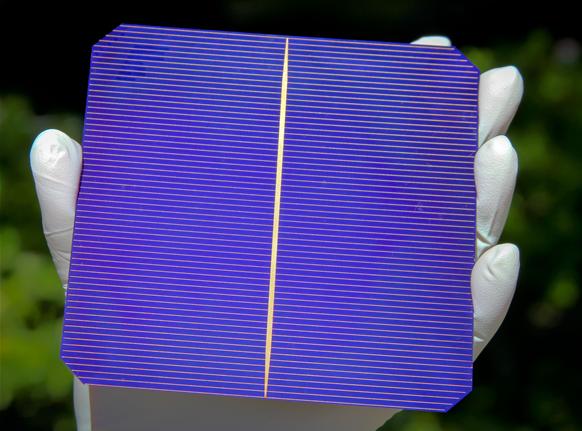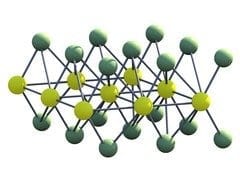
They’re one step closer.
In a new paper in the Journal of Physical Chemistry Letters, Assistant Professor of Chemistry and Biochemistry Kenneth Hanson and his team have introduced a new strategy for generating more efficient solar cells. The team is composed of post-doctoral researcher Tanmay Banerjee and graduate students Sean Hill and Tristan Dilbeck.
“We’re looking not only for new materials but also new light harvesting processes to make solar cells better,” Hanson said.
Though solar cells have grown in popularity, they are still not widely used by the general public as an energy source due to their high cost and low efficiency. A typical solar cell, at maximum, converts less than 33 percent of light into electricity, so researchers have been working to find ways to surpass this limit and make cells more efficient.
In the past, scientists have put an extra photon upconversion filter before or after the cell to catch the low energy, unused light and convert it into usable, high-energy light. But, Hanson wanted to integrate this process directly into the cell.
The researchers were able to do that by using self-assembly. Through a soaking procedure, they assembled two molecules, an acceptor and sensitizer, on a surface. Once assembled, these molecules work in concert to perform photon upconverion, combining two low energy, green photons to generate a higher energy, blue photon, which can then be used to generate electricity.
Using this process in an optimized solar cell can increase the maximum efficiency from 33 percent to more than 45 percent. The team is also confident they can generate even better numbers in the future.
“It’s definitely a stepping stone toward making more
,” Hanson said. “Our current work demonstrates a feasible method.”
Scientists worldwide have been working on how to make more efficient solar cells through a variety of mechanisms and different materials. The solar market has grown considerably over the past few years, and as emphasis on clean energy grows, more resources will likely be devoted to creating better solar options.
Read more: FSU Researchers Pushing Limits of Solar Cells
The Latest on: Efficient Solar Cells
[google_news title=”” keyword=”Efficient Solar Cells” num_posts=”10″ blurb_length=”0″ show_thumb=”left”]
via Google News
The Latest on: Efficient Solar Cells
- A strategy to boost the efficiency of perovskite/organic solar cellson April 28, 2024 at 6:00 am
So far, organic solar cells have achieved a maximum certified power conversion efficiency (PCE) of 19.4%, which is lower than that exhibited by silicon solar cells. A proposed strategy to boost their ...
- How Many Solar Panels Does It Take To Power An RV/Motorhome?on April 26, 2024 at 11:15 pm
Solar power for RVs is taking off, so if you're looking to add some solar panels to your vehicle, it can take some math to figure out exactly what you need.
- Solar Energy Newson April 26, 2024 at 5:00 pm
Apr. 8, 2024 — Researchers have fabricated a new four-terminal organic solar cell with a tandem configuration with a 16.94% power conversion efficiency (PCE). The new device is composed by a ...
- Engineers uncover key to efficient and stable organic solar cellson April 25, 2024 at 7:56 am
A team of researchers led by Professor Philip C.Y. Chow from the Department of Mechanical Engineering at the University of Hong Kong (HKU) has made a significant breakthrough in the field of organic ...
- The Myths And Truths About Why Electric Cars Don't Have Solar Panelson April 25, 2024 at 7:00 am
Although solar energy alone cannot fully power a car for real-world usage, manufacturers are overcoming challenges and getting closer by the hour.
- Key to efficient and stable organic solar cellson April 24, 2024 at 5:00 pm
Their research, titled "The role of interfacial donor-acceptor percolation in efficient and stable all-polymer solar cells," paves the way for more sustainable and viable solar energy solutions for ...
- Ultra-thin, flexible solar cells demonstrate their promise in a commercial quadcopter droneon April 24, 2024 at 9:27 am
Whether on Earth or in space, autonomous energy is critical in order to keep power systems running independently for extended periods of time, particularly in remote or unpredictable environments.
- Researchers develop ‘half-tandem’ perovskite solar cells with conversion efficiency of 27.63%on April 19, 2024 at 2:53 am
Khajeh Nasir Toosi University of Technology reserachers have developed ‘half-tandem’ solar cells with a power conversion efficiency of 27.63% ...
- How Much Do Solar Panels Cost In 2024?on April 15, 2024 at 11:19 pm
This higher efficiency comes at a cost, as most monocrystalline solar panels cost more to purchase and install than their counterparts. The average cost for polycrystalline solar panels ranges ...
- 5 Most Efficient Consumer Solar Panels For 2024on April 15, 2024 at 5:00 pm
But despite their clean energy reputation, different solar panel models perform differently, varying in what the industry calls efficiency rates. We'll take you through the most efficient solar ...
via Bing News










